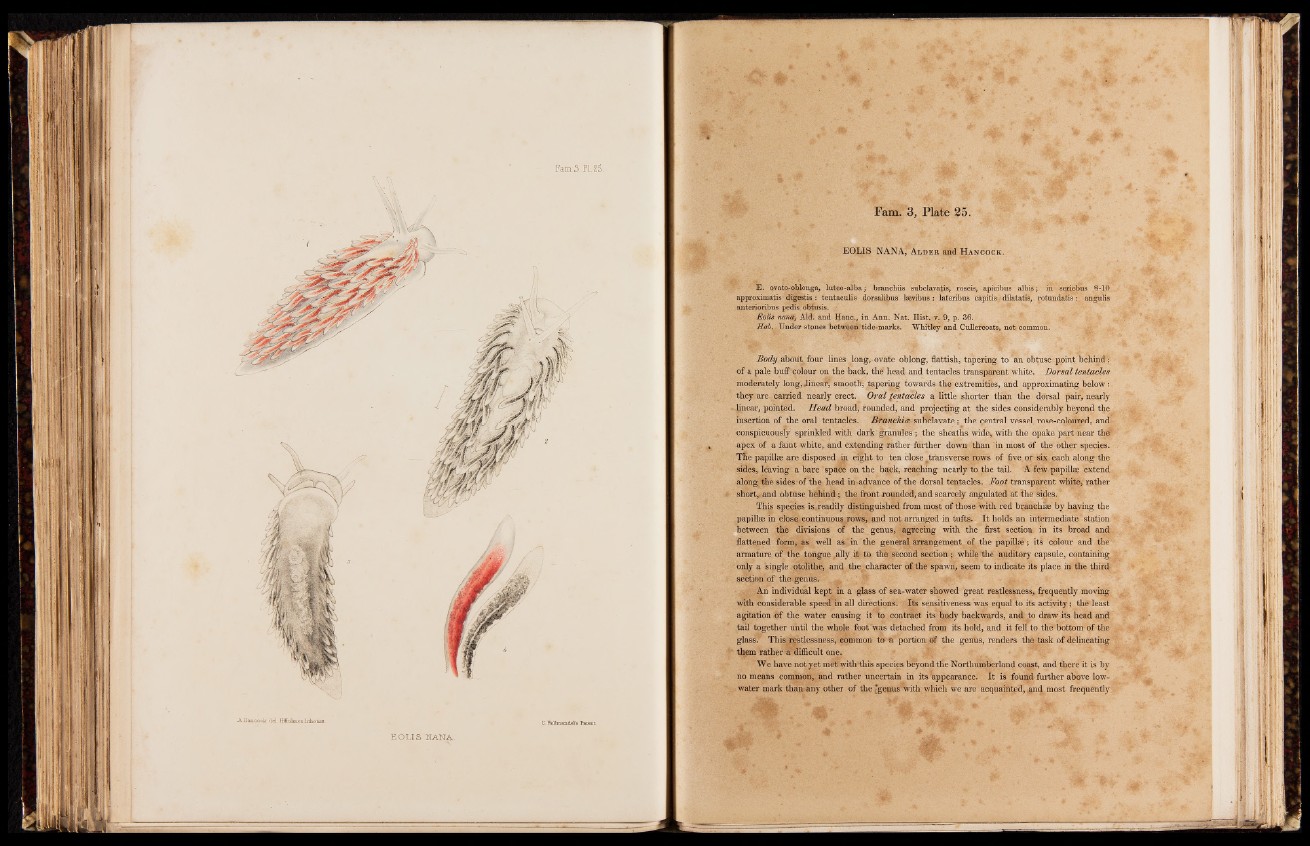
Fam.' 3, Plate 25.
EOLIS NANA, A l d e r a n d H a n c o c k .
E. ovato-phlonga, luteo-alba; branchiis subclavatis, roseis, apicibus al bis; in seriebus 8-10
approximatis digestis : tentaculis dorsalibus lsevibus : lateribus capitis dilatatis, rotundatis :. angulis
anterioribus pedis obtusis.
Eolis nam, Aid', and Hanc., in Ann. Nat. Hist. -v. 9, p. 36.
Hab, - Under stones between !tide-marks. Whitlfey and Cullercoats, not common.
Body aboiit four lines long, ovate oblong, flattish, tapering to “"an obtuse point behind ;
of a pale buffftcolour on the back, the head and tentacles transparent white. Dorsal tentacles
moderately long, Jinearf smooth^ tapering towards the extremities, and approximating below:
they are carried nearly erect. Oral tentacles a little shorter than the dorsal pair, nearly
linear, pointed. Head broad, rounded, and projecting at the sides considerably beyond the
insertion of the oral tentacles. Branchice suoclavate; the central vessel rose-coloured, and
conspicuously sprinkled with dark granules ; the sheaths wide, with the opake part near the5
apex of a faint white, and extendingsfather further down than in most of the other species.
Tne papillee are disposed s in eight to ten close transverse rows of five or six'each along the
sides, leaving a bare space on the back, reaching nearly to the tail. A few papillae extendi
along the sides of the head in advance of the dorsal tentacles. Foot transparent white, rather
shorthand obtuse behind; the. front rounded, and scarcely angulated at the sides.'
This species is^readily distinguished from most of those with red branchiae by having the
papillae in closer continuous,.rows, and not arranged in tufts. It holds an intermediate’station
between .the divisions of the genus^agreeing with the first section in its broad and,
flattened form, as well as in the general arrangement of the papillae; its colour and the
armature of the tongue „ally it' to the Second section ; while 'the auditory capsule, containing,
only a single otolithe, and the^character of the spawri, seem to indicate its place in the third
section of the gemis.
. , An individual kept in a glass of sea-water showed great restlessness, frequently moving
with considerable speed in all directions. Its sensitiveness was equal to its activity; the least
agitation of the water causing it to contract its bpdy backwards, and to draw its head and
tail together until the whole foot was detached from its hold, and it fell to the bottom of the
glass. This restlessness, common to* a portion <jf the getiüs, renders the task of delineating
them rather-a' difficult one.
We have notyet met with this species beyond tfie Northumberland coast, and there it is by
no means common, and rather uncertain in its appearance. It is found further above low-
water mark than any other of the [genus %ith which we are acquainted, .and most frequently